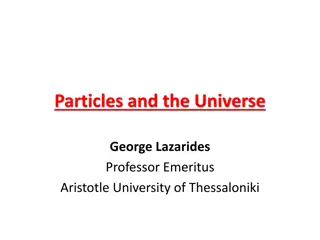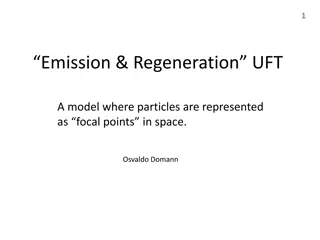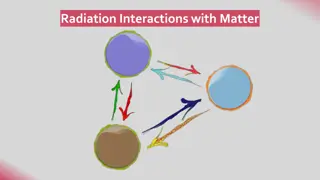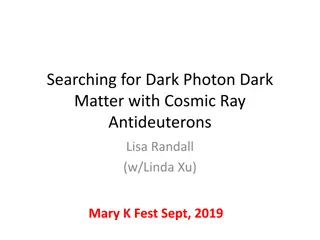Exploring Dark Matter and Fundamental Particles Research Updates
This collection of images and information delves into the research activities led by Mauro Raggi and P. Valente from Sapienza Università di Roma and INFN Roma. It discusses the challenges and possibilities in parameter space coverage, potential tests required for efficient extraction from electron storage rings at DAFNE, and the need for solid background studies for dark photons and feebly interacting particles. The updates also highlight advancements in visible and invisible decays, ALPs scenarios, and long-term strategies for exploring low-mass regions. Additionally, it covers the competition between different experiments like NA64, Belle II, Mu3e, and LHCb in the quest for new physics discoveries.
Download Presentation

Please find below an Image/Link to download the presentation.
The content on the website is provided AS IS for your information and personal use only. It may not be sold, licensed, or shared on other websites without obtaining consent from the author. Download presentation by click this link. If you encounter any issues during the download, it is possible that the publisher has removed the file from their server.
E N D
Presentation Transcript
FFF Referee questions Mauro Raggi and P. Valente, Sapienza Universit di Roma e INFN Roma 1
The questions In terms of parameter space to be covered, the SC remarks that there is a strong competition elsewhere. Please comment on the issue. Expert in the SC remark that slow/resonant extraction from an electron storage ring is known to be feasible, yet the question remains if it can be done efficiently at DAFNE. Dedicated tests might be needed to address this question. Please comment. The background studies for the searches of dark photons/feebly interacting particles should be considerably substantiated, in order to arrive at much firmer conclusions regarding their potential reach. Please comment. 2 Mauro Raggi, Illuminating Dark Matter
L. Darme FFF Jan 2021 status https://agenda.infn.it/event/25299/contributions/127685/attachments/78132/100857/ProspectsLNF2.pdf Visible decays A Invisible decays A Best opportunities for the future in visible decays. Lifetime limits NA64 exclusion power for visible decays. Visible decays ALPs ALPs In ALPs scenario best results in gae ALPs electron coupling. 3 Mauro Raggi, Sapienza
Parameter space A visible next 5Y Region of low masses <20 MeV dominated by NA48/2 and g-2. Both are model dependent bounds - NA48/2 is using protons - g-2e can be cancelled in more complex dark sectors - conflicting experimental results currently differing at more than 3 and of opposite sign arXiv:2104.10280 Main competitors Mu3e and LHCb. - LHCb Both search strategies rely on the planned upgrade to a triggerless-readout system at LHCb in Run 3 (2015). PhysRevD.92.115017 (meson decays) - Mu3e phase I only will be in next 5 years 4 Mauro Raggi, Sapienza
parameter space invisible-visible A long term Invisible Visible CERN PBC Nature: https://www.nature.com/articles/s41567-020-0838-4.pdf Invisible: - Only NA64 and possibly Belle II will have results in the next 5 years - NA64 limits extrapolated to 0 BG with another 2 orders of magnitude increase in statistics! Visible: - Only NA64 may have results in the next 5 years in PADME region - NA64 limits extrapolated to 0 BG. Current mass limit 20 MeV 5 Mauro Raggi, Sapienza
ALPs visible and invisible Nardi Darme et al. JHEP06(2021)009 Invisible: Dominated by NA64 and possibly Belle II will have results in the next 5 years NA64 limits extrapolated to 0 BG with another order of magnitude increase in statistics Visible: Most of the experiments in the plot are not yet approved missing NA64 in the projection see previous slides. - - - - 6 Mauro Raggi, Sapienza
Question II - The POSEYDON first idea (S. Guiducci, P. Valente) was assuming a pure 1/3rd of integer resonance-driven extraction from the positron main ring. Crystal-assisted extraction was already mentioned as a possibility in 2017 proposal. - Deeper studies have been performed in the last two years, in the context of the SHERPA grant (M. Garattini, O. Blanco, S. Guiducci, P. Valente) with two significant new elements (https://arxiv.org/abs/2110.02816): The deflection in a thin crystal is used as a first non-local kick, replacing the electrostatic septum of the classical scheme The idea of using the smaller and simpler accumulator ring has been studied with some detail The simulations are quite advanced but mainly on the beam dynamics. What is still missing or ongoing: 1) Detailed simulations of coherent processes in the crystal 2) Integration of the crystal effect with the tracking of particles in the ring Concerning the crystal and its mechanical system, the realization of the first holder+crystal is fairly advanced. To be done: 3) Assemble and bend the crystal inside its dynamic holder, mount it on the existing goniometer 4) Assemble the detectors and the vacuum pipes for measuring the particle deflection 5) Perform the beam-test with 0.5 GeV positrons in the BTF line (backup: MAMI with 0.9 GeV electrons or CERN East Area), characterizing the crystal On the machine side: 6) Perform a first extraction test without the crystal in the accumulator, downstream of the existing magnetic septum, and compare with simulations 7) Requires additional beam diagnostics/monitoring 8) Modify the goniometer+holder+crystal in the accumulator ring for installation in the accumulator ring 9) Design the vacuum integration of the goniometer+holder+crystal in the accumulator and the modifications to the ring layout 10) Install the system in the accumulator and perform a complete extraction test 7 Mauro Raggi, Sapienza
Question III: BG estimates As shown in previous slides the best opportunities are in the future for visible decays. The present estimates are based on PADME invisible setup and extrapolated to higher number of POTs Preparing a more solid estimates for visible decays requires the design of a baseline detector for the PADMEII runs at extracted line. An experimental setup dedicated to visible decays might get a better BG rejection with respect to present extrapolations. Bump hunt technique can be used measuring e+e invariant mass. As shown by L. Darme different technique can be used at an extracted beam line (i.e. missing mass or energy) The BGs in this configurations are not known but expected to be lower. The effort of performing more realistic BG studies for future experiments at extracted lines requires man power from outside the presentPAMDE collaboration. 8 Mauro Raggi, Sapienza
backup slides 9 Mauro Raggi, Sapienza
Mu3e at Shedding light 2021 Mu3e update at: https://agenda.infn.it/event/26303/contributions/135210/attachments/84295/111625/Mu3e_Perrevoort.pdf 10 Mauro Raggi, Sapienza
(g-2)e from last measurement https://www.nature.com/articles/s41586-020-2964-7 11 Mauro Raggi, Sapienza























